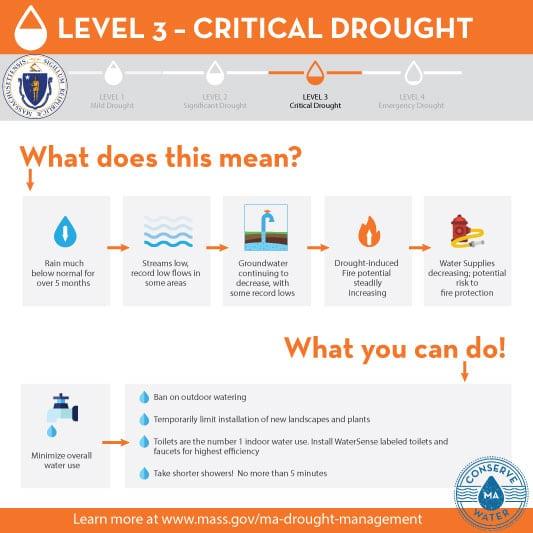LYNNFIELD – Early last week, the Lynnfield Center Water District implemented a full outdoor water ban in response to prolonged hot and dry weather and higher-than-normal customer demand.
The Level 5 ban began on July 25, recognizing drought and emergency conditions outdoor watering of any kind is not allowed while the District remains at this restriction level. The designation came following a six-day-plus heat wave in which the demand on the District water system was almost consistently double the daily average of 550,000 gallons. As Lynnfield enters into another five to six-day heat wave coupled with oppressive weather conditions, LCWD urges residents to be mindful of the restrictions.
The District maintains a year-round watering restriction schedule as mandated by the State Department of Environmental Protection, but increases restrictions based on current conditions. A Level 3 restriction (limited outdoor watering) went into place on May 13, and a Level 4 restriction (watering by hose or can, no non-essential use) went into effect on June 16.
The State of Massachusetts has declared a Level 3 Critical Drought, which recognizes below-normal rainfall for five months, low to record-low stream flow, and decreasing groundwater. More than 40 percent of the state is considered to be under drought conditions. More than 130 communities in Massachusetts have restricted water use, including Reading, Danvers, Middleton, Peabody and Wilmington, to name a few.
“We are a utility. Our objective is to provide water for people to use. But currently, our system can only produce so much and we need to prioritize system pressure and fire suppression ahead of outdoor watering,” Board of Water Commissioners Chairman Jack Adelson said. “For now, we have no choice but to implement the restrictions and have residents comply. We are not alone. Most communities around us and across the state are in the same situation. Just drive around and look at streams and ponds and other open bodies of water. Everything is very dry.”
The District currently draws its supply solely from groundwater via pumps, which must be monitored and need down time to ensure maximum well production.
“The weather pattern has absolutely had an impact on this situation. Almost instantaneously, from May 11-14, demand increased from an average of around 750,000-800,000 gallons per day to almost 1 million gallons per day, and we have not looked back. That was an almost overnight 20 percent increase,” Superintendent John Scenna said.
“Our system has been running pretty much straight out to keep up with demand,” Superintendent Scenna said. “Our wells are showing stress and fatigue as demand remains high, so we are getting squeezed on both ends.”
When daily demand exceeds supply, the District system draws water from storage tanks at Knoll Road and Wing Road. Overnight water use limits the system’s ability to recover and refill the tanks. At times, the District has recorded overnight water use in the early morning, pre-dawn watering hours of about 150,000 to 200,000 gallons, which lowers tank levels by five to six feet and limits their ability to recharge in time for daily residential use. Repetitive days of similar use eventually impact system operating pressures and fire suppression.
During the heat wave, the District issued a Code Red reminder about the Level 4 restriction and asked customers to limit water use. “Unfortunately, the response was not positive and demand stayed steady and at high levels throughout the weekend heat,” Superintendent Scenna said.
The District and Board of Water Commissioners initiated a Capital Program that includes an interconnection with the Town of Wakefield water system, gaining access to Massachusetts Water Resources Authority water, and the construction of a new greensand filter plant at Glen Drive. When completed, these projects will significantly increase the quality and quantity of available water supply and reduce the need for usage restrictions. A video of this presentation and the presentation slides can be found here.
“When additional supply sources come online, we will have more options available,” Chairman Adelson said. “We’ve worked very efficiently and hard over the past two-plus years to put these projects in place, and greatly appreciate the support from customers.”
###
Discover more from John Guilfoil Public Relations
Subscribe to get the latest posts sent to your email.

